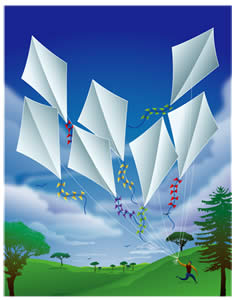
Unit 1 Activities
Pair
“Greeting each other: Practicing greetings”
Estimated time:
15 minutes
Materials:
Teacher/parent -made signs representing the times of day (e.g.: a sun
for morning, clock showing 12:00 noon for midday, and a moon and stars
for night), light switch, flash light, music (optional)
Objective(s):
The students will respond appropriately to greetings in the target language.
The students will greet each other in the target language, using the expression
appropriate to the time of day.
Procedure:
The teacher/parent reminds the students of the importance of greetings,
and how to greet people in the target language. The teacher/parent reviews
the appropriate target language greetings for each time of day (e.g.:
“good morning,” “good day,” “good evening,”
“good night,” etc). The teacher/parent models and practices
the following activity with the students, who are then asked to work on
the activity in pairs.
Teacher/parent uses signs representing time of day to room lights/flash light/other cues to elicit expressions appropriate to different times of day. The students work in pairs, greeting each other with the expression appropriate to the time of day. For example, when the classroom lights are on, and the teacher/parent holds up a sign with a picture of a sun, the pairs greet each other, saying “good morning” in the target language. When the lights are out, and the teacher/parent holds up a sign with a picture of the moon and stars, the students greet each other saying “good night.” A flash light in a dark room can symbolize evening. The teacher/parent can use his or her creativity to come up with variations on these ideas. For example, musical cues can be used in addition to visual cues and changes in light.
The activity becomes a fun game as the students get better at recognizing cues and greeting their partners. The teacher/parent should begin quickening the pace of the cues, so that the students have to move/respond faster and faster. Eventually, a student leader or leaders can take over the teacher/parent’s role.
Assessment/Monitoring Progress:
This activity should be relatively easy for the students once they have
learned the material in Unit 1. If students run into difficulty, try limiting
the number of greetings that they have to choose from in the activity.
It is a great idea to repeat this activity often, perhaps coming up with
more difficult variations. The students may have some creative ideas and
suggestions. Students enjoy taking over the teacher/parent’s role,
and enjoy the fast pace of the activity as it becomes a game that gets
faster and faster. Encourage students who are willing to take on the teacher/parent’s
role as it will allow them more opportunities to use the target language
and to take responsibility for and pride in their language learning.
Group
“Mixed-up Name Tag Mystery”
Estimated time:
10 to 20 minutes (dependent on class size)
Materials:
Small pieces of paper (enough for group size), markers or pens, sticky
tape, hat or box, costumes/disguises (optional)
Objective(s):
The students will introduce themselves to their classmates in the target
language.
The students will match name tags to the correct students.
Procedure:
The teacher/parent tells the students that they will be solving a real-life
puzzle today. All of their names will be mixed-up, and they will have
to solve the mystery!
Each student is asked to write his or her name on a small piece of paper to make a name tag. The teacher/parent collects all of the name tags, and drops them in a hat or a box. Each student then chooses a name tag from the hat or box, and makes sure it is not his or her own name. Each student tapes the “incorrect” name tag to his or her shirt. If desired, the students can dress up in costumes/disguises (e.g.: a hat or other item specific to the target culture). The teacher/parent models the following activity with an individual student, and then asks the students to do it as a group:
In the activity, all of the students walk around the room, introducing
themselves to each other in the target language. Because the students’
name tags are all mixed up, the students’ name tags will not match
their “real” names. When a student finds the person who has
received the name tag that has his or her “real” name, the
student claims his or her name by switching name tags with that person,
and sitting down until the “entire mystery is solved”. The
game continues until all of the students have the “correct”
name tags on their shirts.
Assessment/Monitoring Progress:
During the activity, the teacher/parent should facilitate by moving around
the room and assisting students with the target language. Make sure the
instructions are clear. If students have trouble with the activity the
first time, try modeling it again and doing the activity with a smaller
group. The students can benefit by doing this activity more than once.
If the students still have trouble with the activity, the teacher/parent
should review the target language greetings found in Unit 1 with the students.